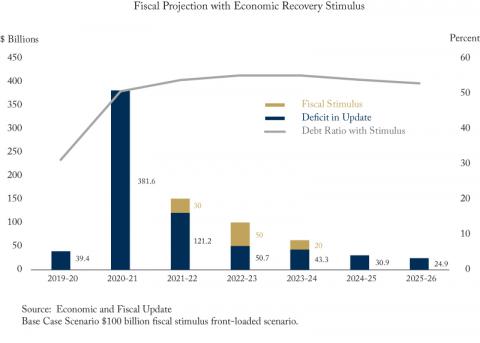From: Don Drummond
To: Chrystia Freeland, Deputy Prime Minister and Minister of Finance
Date: December 16, 2020
Re: Through the Fiscal Fog: Large Deficits and Debt as Far as the Eye Can See
I recently set out four wildly differing federal fiscal scenarios for the future. Recent Government of Canada announcements lift the fog enough to narrow possibilities. We can now see clearly that the future features large, ongoing deficits with a high public debt burden. Canadians now have enough of a context to debate whether they accept the associated risks and to weigh in on how expensive future initiatives should be best designed.
The Fall Economic Statement provided a 5-year projection that tallies the fiscal impact of policy decisions to date and references some, but far from all, likely future fiscal pressures.
How does this all add up? I take the Statement’s base case scenario and assume the $70-100 billion economic recovery stimulus package is used fully and front-loaded from 2021-22 through 2023-24 (see Figure).
The Statement was selective in the future fiscal pressures it referenced. It gave a range for the cost of the intended fiscal stimulus package, but set aside no or only partial funds for other intended policy actions. For example, the Statement:
- Indicates that Fiscal Stabilization Program reform will provide billions of dollars more for qualifying provinces, but provides no provisions for it.
- Reflects the government’s decision to freeze the Employment Insurance contribution rate at its 2020 level through 2022, but is silent on what happens after. The projection of Employment Insurance revenue suggests premium hikes are assumed beginning in 2023. That would mean that premiums rise while the economic stimulus package is still in effect. That would be rowing upstream. The premium rate freeze will likely be extended and this will become part of the cost of the economic recovery package or there will be a hit to the deficits from 2022-23 on.
- Provides for almost $7 billion of spending over 10 years to combat climate change. Within 2 weeks of the Statement, the climate change plan was announced with $15 billion of spending over 10 years. While a reconciliation between the two statements is not perfectly clear, it would appear there is now an additional $8 billion hit to the deficit over 10 years on top of what was projected in the Statement.
- Has no provision for childcare. Of all the major spending initiatives contemplated by the Liberal Party, one gets the sense from the Statement that an early learning and national childcare program has a particularly high priority. If such a scheme were modelled on Quebec’s program, the cost could easily be $7 billion per annum.
- Has $1 billion split over this fiscal year and next for provinces and territories for long-term care, joining an existing federal program for home care. But these are time-limited funds whereas the policy needs of provinces and territories are ongoing and increasing. Will Ottawa wade into a lasting provincial problem then flee? Unlikely.
- Keeps a tight lid on the growth rate of the Canada Health Transfer – capped at the growth of nominal GDP with a floor of 3 percent per annum. Yet, the Council of the Federation is asking for another $28 billion per year. The Prime Minister has indicated an openness to more money for provinces and territories, but has been non-committal on amount and form. It is highly unlikely there will be anything like the provincial ask, but the pressure is easily in the billions of dollars.
- Assumes the fiscal stimulus will be in place from 2021-22 through 2023-24 and then disappear. That may be easier said than done. The needs these programs address are typically ongoing and make programs difficult to withdraw.
- Does not provide funding for any of the other mega-initiatives that have been proposed for many years by the Liberal Party. National Pharmacare has been featured in most Liberal documents but seemed downplayed in the Statement. That would require provincial co-operation that is unlikely without a federal commitment on funding. That is a potential $20 billion annual pressure.
There are many other initiatives in the Speech from the Throne that are not costed in the Statement. A partial list includes: higher Old Age Security as of age 75, a new Canadian Disability Benefit, and a National Training Strategy. Collectively they would add another several billions of dollars to annual spending. A basic income would add even more.
And there is potentially more fiscal risk on the horizon for core federal responsibilities. Indigenous Services Canada has estimated compliance with the Canadian Human Rights Tribunal ruling on First Nations child welfare could cost $5.3 billion, but the Statement does not appear to have a provision. And satisfying the commitment to NATO to bring defence spending to 2 percent of GDP could cost $15 billion annually.
We know from the Statement that the Government of Canada proposes, and is seemingly comfortable with, running a net debt-to-GDP ratio above 50 percent for many years. Reflecting on the many uncosted policy intentions, we should consider the probability that the debt burden will be somewhat higher than this over the next several years and take longer than depicted in the Statement to begin to decline.
It is now time for Canadians to have a national debate on appropriate fiscal risks, the value of several mega-initiatives and how best they can be designed for effectiveness, efficiency and affordability.
Don Drummond is the Stauffer-Dunning Fellow in Global Public Policy, School of Policy Studies, Queen’s University
To send a comment or leave feedback, email us at blog@cdhowe.org.
The views expressed here are those of the author. The C.D. Howe Institute doesn’t take corporate positions on policy matters.






